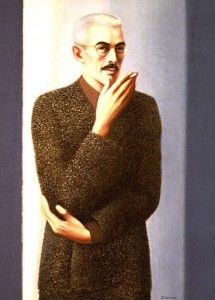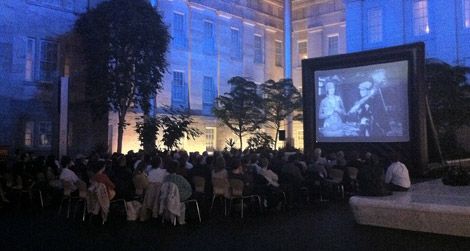Historian Amy Henderson: Movies Make Museums Move
Guest blogger Henderson ponders the idea that the big screen deserves its own gallery
/https://tf-cmsv2-smithsonianmag-media.s3.amazonaws.com/filer/20110923012004henderson-boa.jpg)
This post is part of our on-going series in which ATM invites the occasional post from a number of Smithsonian Institution guest bloggers: the historians, researchers and scientists who curate the collections and archives at the museums and research facilities. Today, Amy Henderson from the National Portrait Gallery weighs in on cinema as art. She last wrote for us about David McCullough visiting the Smithsonian.
What is it about the “moving image” that stops us in our tracks? If someone posts a video on your Facebook wall, aren’t you more likely to click through than you are to other links? Why do we watch movies on our cell phones? Why is there a pedestrian mall in Times Square, where zillions of people sit in beach chairs and gaze at images beamed back in surround sound? In museums, visitors always crowd the moving image galleries. Why does video so stimulate the mind?
In the early 20th century, when film was silent and actors anonymous, people streamed into theaters to watch projections flicker across the silver screen. After the advent of “talkies,” Hollywood studios created a parallel universe of “larger-than-life” stars. Women bleached their hair platinum blonde in homage to Jean Harlow in Red Dust, and men drank martinis as if they were William Powell in The Thin Man. We wanted to wear what stars wore on screen: in the midst of the Depression, the sewing company Butterick sold 500,000 patterns of the puffed-sleeve dress Joan Crawford wore in the 1932 Letty Lynton, even suggesting less expensive materials for home sewers to substitute for the film star’s silk. The rapture seems limitless.
I’m fascinated by how movies define culture. Pre-movie America is chronicled in various media, but nothing moves—all that we have to examine from that era is static, like delicate butterflies pinned in a display case. And in fact, we have a hard time imagining those freeze-framed individuals moving, breathing, talking, walking, singing, even just going about their daily routines. When I take visitors through the Portrait Gallery’s exhibition “America’s Presidents,” I remind them that we don’t really know what our Founding Fathers even looked like, except as depicted by different artists; and we can only guess at what they sounded like.

I thought about film’s power to reveal recently as I prepared to introduce a screening of The Maltese Falcon at the Portrait Gallery. This 1941 movie marked John Huston’s debut as a director and Humphrey Bogart’s transition from typecast gangster to star. It is unmistakably Depression-era in its noirish shadows; like Dashiell Hammett’s 1930 novel of the same name, the movie’s narrative clips along like a newsreel; private eye Sam Spade (Bogart), the Fat Man (Sydney Greenstreet), and Joel Cairo (Peter Lorre) are drawn boldly and speak in rapid-fire dialogue that reinforces the film’s staccato beat. The story’s captured moment leaves little time for nuance or subtlety; the narrative ruthlessly and relentlessly moves.
This staccato beat is a theme I emphasize when I take people through the Portrait Gallery’s exhibition of the 1920s through the 1940s—years that saw the rise of modern America. Between 1890 and the 1920s, 23 million immigrants had arrived on America’s shores; most were from Southern or Eastern Europe. Few spoke English. In that period, the face of the country changed. At the same time, the pastoral landscape of Emerson and Thoreau morphed into cityscapes: the 1920 Census showed that, for the first time, America was more urban than rural. New York emerged as a vast center of consumer culture, a billboard-and-neon furnace stoking—in one of my favorite phrases—“a staggering machine of desire.” It was a city that gave its pulse to Gershwin’s rhythms, Martha Graham’s choreography, and Dashiell Hammett’s hard-boiled fiction.
“Moving pictures” were a perfect metaphor for America’s rapidly changing staccato culture. Emerging in the dynamism of New York street life, movies won instant success as pop-up entertainment when entrepreneurs like Adolph Zukor, Louis B. Mayer and William Fox set up storefront theaters in the immigrant tenements of the Lower East Side. Language was no obstacle, so silent movies had a ready-made audience.
The ability of movies to transport us has remained one of this medium’s chief attractions. The irony is that while film is a remarkable cultural document that freezes time, it also removes us from the mundane.
Allison Jessing, a program coordinator who organizes film series here at the Portrait Gallery and the Smithsonian American Art Museum, told me that “film can be just as subversive, powerful and emotionally resonant as painting, sculpture, or any other traditional art form.” She believes that Smithsonian theaters should be considered galleries in their own right, “showcasing masterpieces the same way that we exhibit artworks that sit on a pedestal or hang on a wall.” One of the ways Jessing is doing this is by borrowing the “pop-up entertainment” technique from movies’ early entrepreneurs. To that end, the museums have purchased an inflatable 16-foot pop-up wide screen for projecting films in the Kogod Courtyard, and Allison will use the big screen for a larger-than-life series she’s calling “Courtyard Cinema Classics.”

On November 15, the first in the series will be presented—the 1949 A Connecticut Yankee in King Arthur’s Court, a time-travel musical starring Bing Crosby and Rhonda Fleming. I am delighted to be introducing this film, which is based (very roughly) on Mark Twain’s 1889 novel of the same name; I may wear my boa.
Showcasing movies in museums proves once again that Sam Spade was right: they’re the stuff that dreams are made of.